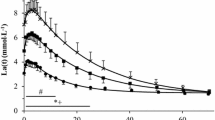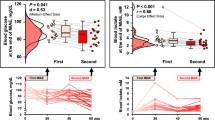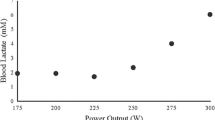Abstract
We investigated the role of the forearm skeletal muscles in the removal of lactate during repeated periods of short-term intensive leg exercise, i.e. a force-velocity (FV) test known to induce a marked accumulation of lactate in the blood. The leg FV test was performed by seven untrained male subjects. Arterial and venous blood samples for determination of arterial ([la−]a) and venous ([la−]v) plasma lactate concentrations were concomitantly taken at rest before the test, during the FV test at the end of each period of intensive exercise just before the 5-min between-sprint recovery period, and after the completion of the test at 2, 4, 6, 8, 10, 15, and 20 min of the final recovery. The arteriovenous difference in concentration for plasma lactate ([la−]a−v) was determined for each blood sample. During the test, [la−]a and [la−]v increased significantly (P < 0.001;P < 0.001) with significantly higher values for [la−]a (P < 0.001). At the onset of the test, [la−]a−v became positive and increased up to a braking force of 6 kg, correlating significantly with [la−]a (r = 0.61,P < 0.001) with power (r = 0.58,P < 0.001) during the test. At the end of the test, [la−]a, [la−]v and [la−]a−v decreased (P < 0.001;P < 0.001;P < 0.001 respectively) but were still higher than the basal values after 20-min of passive recovery. In conclusion, forearm skeletal muscles would seem to have been involved in the removal of lactate from the blood during the leg FV test, with an increase in lactate uptake proportional to the increase in plasma lactate concentration and power.
Similar content being viewed by others
References
Ahlborg G, Felig P (1982) Lactate and glucose exchange across the forearm, legs, and splanchnic bed during and after prolonged leg exercise. J Clin Invest 69:45–54
Ahlborg G, Hagenfeldt L, Wahren J (1975) Substrate utilization by the inactive leg during one-leg or arm exercise. J Appl Physiol 39:718–723
Andres R, Cader G, Zierler KL (1956) The quantitatively minor role of carbohydrate in oxidative metabolism by skeletal muscle in intact man in the basal state. Measurements of oxygen and glucose uptake and carbon dioxide and lactate production in the forearm. J Clin Invest 35:671–682
Baldwin W, Hooker A, Herrick R (1978) Lactate oxidative capacity in different types of muscle. Biochem Biophys Res Commun 83:151–157
Bang O (1936) The lactate content of blood during and after muscular exercise in man. Skand Arch Physiol 74 [Suppl 10]:51–82
Bedu M, Fellman N, Spielvogel H, Falgairette G, Van Praagh E, Coudert J (1991) Force-velocity and 30-s Wingate tests in boys at high and low altitudes. J Appl Physiol 70:1031–1037
Brooks G (1986) The lactate shuttle during exercise and recovery. Med Sci Sports Exerc 18:360–368
Buckley J, Scroop G, Catcheside P (1993) Lactate disposal in resting trained and untrained forearm skeletal muscle during high intensity leg exercise. Eur J Appl Physiol 67:360–366
Catcheside P, Scroop G (1993) Lactate kinetics in resting and exercising forearms during moderate-intensity supine leg exercise. J Appl Physiol 74:435–443
Delgado A, Allemandou A, Peres G (1993) Changes in characteristics of anaerobic exercise in the upper limb during puberty in boys. Eur J Appl Physiol 66:376–380
Duche P, Falgairette G, Bedu M, Lac G, Robert A, Coudert J (1993) Analysis of performance of pubertal swimmers assessed from anthropometric and biometric characteristics. Eur J Appl Physiol 66:467–471
Freyschuss U, Strandell T (1967) Limb circulation during arm and leg exercise in supine position. J Appl Physiol 23:163–170
Gertz E, Wisneski J, Neese R, Bristow J, Searle G, Hanlon J (1981) Myocardial lactate metabolism: evidence of lactate release during net chemical extraction in man. Circulation 63:1273–1279
Jorfeldt L (1970) Metabolism of L(+)-lactate in human skeletal muscle during exercise. Acta Physiol Scand [Suppl] 338:1–67
Linossier MT, Denis C, Dormois D, Geyssant A, Lacour JR (1993) Ergometric and metabolic adaptation to a 5-s sprint training programme. Eur J Appl Physiol 67:408–414
Mercier J, Mercier B, Préfaut Ch (1991) Blood lactate increase during the force-velocity exercise test. Int J Sports Med 12:17–20
Mercier B, Granier P, Mercier J, Trouquet J, Préfaut Ch (1993) Anaerobic and aerobic components during arm-crank exercise in sprint and middle-distance swimmers. Eur J Appl. Physiol 66:461–466
Mercier B, Granier P, Mercier J, Anselme F, Ribes G, Préfaut Ch (1994) Effects of 2-chloropropionate on venous plasma lactate concentration and anaerobic power during periods of incremental intensive exercise in humans. Eur J Appl Physiol 68:425–429
Newsholme E, Leech A (1988) Biochemistry for the medical sciences. Wiley, New York
Oyono-Enguelle S, Gartner M, Marbach J, Heitz A, Ott C, Freund H (1989) Comparison of arterial and venous blood lactate kinetics after short exercise. Int J Sports Med 10:16–24
Peter J, Sawaki R, Barnaed R, Edgerton V, Gillespie C (1971) Lactate dehydrogenase isoenzymes: distribution in fast-twitch red, fast-twitch white, and slow-twitch intermediate fibers of guinea pig skeletal muscle. Arch Biochem Biophys 144:304–307
Poortmans J, Delescaille-Vanden Bossche J, Leclercq R (1978) Lactate uptake by inactive forearm during progressive leg exercise. J Appl Physiol 45:835–839
Stanley W, Gertz E, Wisneski J, Neese R, Morris D, Brooks G (1986) Lactate extraction during net lactate release in legs of humans during exercise. J Appl Physiol 60:1116–1120
Wasserman D, Williams P, Lacy D, Goldstein R, Cherrington A (1989) Exercise-induced fall in insulin and hepatic carbohydrate metabolism during muscular work. Am J Physiol 256:E500-E509
Yoshida T (1984) Effect of exercise duration during incremental exercise on the determination of anaerobic threshold and the onset of blood lactate accumulation. Eur J Appl Physiol 53:196–199
Yoshida T, Takeuchi N, Suda Y (1982) Arterial versus venous blood lactate increase in the forearm during incremental bicycle exercise. Eur J Appl Physiol 50:87–93
Author information
Authors and Affiliations
Rights and permissions
About this article
Cite this article
Granier, P., Dubouchaud, H., Mercier, B. et al. Lactate uptake by forearm skeletal muscles during repeated periods of short-term intense leg exercise in humans. Europ. J. Appl. Physiol. 72, 209–214 (1996). https://doi.org/10.1007/BF00838640
Accepted:
Issue Date:
DOI: https://doi.org/10.1007/BF00838640




